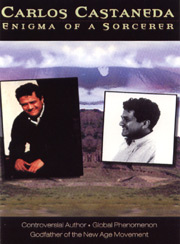|
Carlos Castaneda:
Enigma of a Sorcerer |
| |
 |
UK, 2004. Not rated. 91 minutes.
Featuring:
Amy Wallace, Andra, Richard De Mille, Corey Donovan, Robert J. Feldman, Ron Goldstein, Valerie Kadium, Monica Martinez, Daniel C. Noel, Robert Moss, Victor Sanchez, Melissa Ward, Felix Wolf
Original Music: Ralph Torjan, Robert J. Feldman
Cinematography & Editing: Ralph Torjan
Producers: Ralph Torjan, Pamela Weir-Quiton
Director: Ralph Torjan
LINKS
|
 ometimes called the Godfather of New Age, Carlos Castaneda wrote eleven books in which he claimed to have apprenticed with a Mexican-Indian shaman descended from ancient Toltec sorcerers. According to Castaneda, this shaman, Don Juan Matus, taught him to set aside the conventional modes of interpreting reality that we are taught since birth, and to perceive and even manipulate the flowing energy of the universe. Castaneda, whose first writings earned him a doctorate in anthropology from UCLA, purported to be a “Nagual,” an intermediary to the unknown, and offered classes in perceiving “non-ordinary reality” until his death in 1998. His books and teachings became so popular that he became the subject of a 1970s Time Magazine cover story on “magic and reality” and was a regular denizen of the bestseller lists. To many, however, Castaneda was a fraud, and don Juan Matus a pure fabrication.
ometimes called the Godfather of New Age, Carlos Castaneda wrote eleven books in which he claimed to have apprenticed with a Mexican-Indian shaman descended from ancient Toltec sorcerers. According to Castaneda, this shaman, Don Juan Matus, taught him to set aside the conventional modes of interpreting reality that we are taught since birth, and to perceive and even manipulate the flowing energy of the universe. Castaneda, whose first writings earned him a doctorate in anthropology from UCLA, purported to be a “Nagual,” an intermediary to the unknown, and offered classes in perceiving “non-ordinary reality” until his death in 1998. His books and teachings became so popular that he became the subject of a 1970s Time Magazine cover story on “magic and reality” and was a regular denizen of the bestseller lists. To many, however, Castaneda was a fraud, and don Juan Matus a pure fabrication.
It might have been helpful to have this information clearly and concisely presented up front. Instead, Carlos Castaneda: Enigma of a Sorcerer is a jumbled treatment of the mysterious, reclusive “New Age guru” that is short on facts and long on speculation.
The film is brought to us by Ralph Torjan, a former participant in Castaneda's workshops, including the exclusive and secretive “Sunday Class.” Torjan has loftier goals than simply educating his audience, which he seeks to do by presenting numerous interviews with scholars and members of Castaneda's coterie. Torjan also seeks to stimulate the audience's own perception of “non-ordinary reality” through the use of visuals and music. Unfortunately, Torjan had no funds with which to achieve this goal. The result is a documentary saturated with cheezy Public-Access quality visual effects in which formal exposition is eschewed. This makes for a “non-ordinary” documentary, perhaps, but not one most people will glean much from sitting through. An intentional satire of what people consider to be stereotypically “New Age” could not possibly have resulted in a more exaggerated parody than long segments of this film.

Melissa Ward talks in front of blue-screen effects about her time with Carlos Castaneda. |
The film opens with a bad laser light show combined with floating, distorted images of people talking in sound bites about Castaneda. Torjan intends the irritating score, most of which sounds like it has been produced on a Dollar-Store Casio, to echo Shamanic drumming used on a vision quest. The music's binaural frequency is supposed to link brainwaves to breathing patterns, and help us tap into non-ordinary reality.
What the soundtrack does do is make it difficult to follow what people are saying, and Torjan's failure to present information in a clear way exacerbates the confusion. A small example: the late Daniel Noel of the Pacifica Graduate Institute, a respected school of depth psychology and home of the Joseph Campbell Library, cites a drawing from central Siberia of a man in an antler headdress beating on drum. It bears the caption, “Shaman, or priest of the devil.” Yet Torjan doesn't show the drawing itself. Indeed, he presents almost no evidentiary support or illustrative visuals for any of the statements made by the interviewees. He eventually walks through basic Casteneda teachings and terminology like “tensegrity,” “recapitulation,” and “inner silence,” much of which seems pilfered from various religious traditions and modern-day authors who write about the subjectivity of reality, dream travel, and the collective unconscious.
Instead, Torjan has placed Noel and other interviewees in front of a blue screen, on which he projects high-speed footage cloud formations, vistas shot from airplanes, sound waves, and digitally created bubbles, to name a few. Sometimes he uses the blue screen effects to copy the interviewee so that she appears in duplicate, or even triplicate, while she speaks. Late in the film, after a discussion regarding the suspicious circumstances around Castaneda's death (apparently he succumbed to liver cancer instead of “burning with the fire from within”), Torjan takes a camcorder into the woods and buries his own legs in the dirt as he holds the camcorder with one hand. Most of the images no doubt refer to a lexicon of symbols that Castaneda insiders will recognize, but they mean little to outsiders.
The documentary is not devoid of worthwhile content, however. Castaneda insiders and experts such as Victor Sanchez (author of The Teachings of Don Carlos ) and Robert Moss (author of DreamGates and Conscious Dreaming ) do offer an intriguing portrait of a complex and disturbed individual. We learn that none of the details of the Don Juan stories are verifiable. Moreover, even Castaneda loyalists agree that Castaneda brainwashed women, stringing them along by weaving them into his myths. To his credit, Torjan has persuaded a couple members of Castaneda's extensive harem (which Castaneda culled from his workshops) to be interviewed on camera. One woman, Melissa Ward, recounts how Castaneda convinced her that she was the “Electric Warrior” his inner circle had been desperately seeking. He would tell the women that sexual copulation was the quickest way to impart his knowledge—that his sperm actually changed their brains!
Though Castaneda was greedy, hungry, and insecure, as one person says, most of the interviewees ultimately defend him, agreeing that he was a seeker with “impeccable intent” and that he never claimed to be free of the weaknesses and compulsions of our world. The same people who criticize Castaneda talk about his radiant energy, and assert that wondrous things happened in his workshops. Noel argues that although Casteneda's Don Juan stories are not literally true, they do reflect something of the truth. Similarly, Torjan observes in voiceover that even though Castaneda struggled to embody his own mythology, “the myth held a power all its own.” The most moving testimony comes from former “Private Class” participant Felix Wolf, who surprises himself with his own tears.
The title of the film names Castaneda an enigma, and so he remains. An interviewee observes that a good guru eventually frees his students, while a bad guru keeps them forever on his knee. Torjan's documentary (intentionally or not) seems to place him in the latter category. Though Casteneda consistently claimed not to be seeking devoted followers, he acquired them nonetheless. Definitive conclusions about Castaneda are elusive, however. Partly that's because Casteneda carefully managed the information available to the public about him. It's also because, though he is better positioned than most to investigate Castaneda's legacy, Torjan has not made an investigative documentary. He seems more interested in finding peace for himself and his friends by “bridging the split” between the power of Castaneda's teachings and the hypocrisy of the man himself, who exhorted others to abandon their egos while apparently clinging devotedly to his own.
Torjan has entreated audiences to avoid cynicism, but that just deflects blame for making an unfocused film that fails, at least for this uninitiated viewer, to open a door into any kind of reality, ordinary or otherwise. Despite a few genuinely powerful interview segments, Enigma of a Sorcerer amounts to a sea of talking heads with dreadful graphics. It is possible to combine visuals with interview content to create a heady melange of intellectual and sensory stimulation, as Errol Morris proved in his riveting Fog of War (in which he used a Philip Glass score, new footage, and hypothetical imagery to punctuate and enliven ninety minutes of a guy rambling about foreign policy). Ralph Torjan undoubtedly has an “impeccable intent,” but he is no Errol Morris. In fact, he is no filmmaker at all.
Review © March 2004 by AboutFilm.Com and the author.
Images © 2004 Indican Pictures. All Rights Reserved.


